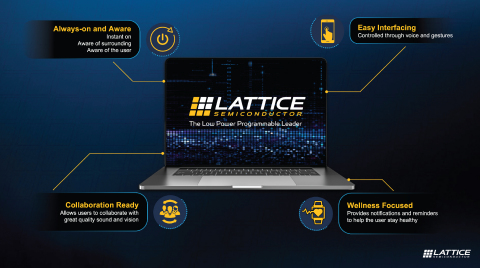New Lattice sensAI Solution Stack Accelerates Next-Generation Client Devices
Lattice Semiconductor Corporation (NASDAQ: LSCC) has unveiled a new roadmap for low power, AI/ML-enabled solutions that enhance battery life and user experience in Edge applications, particularly Client Compute devices. Utilizing the sensAI™ solution stack and Lattice Nexus™ FPGAs, these innovations enable OEMs to create energy-efficient, smart devices with hardware-accelerated AI. The latest sensAI version (v4.1) supports in-field software updates and extends application capabilities, showing a 28% longer battery life compared to traditional CPU-powered AI applications.
- Introduction of low power AI/ML solutions targeting Client Compute devices.
- New sensAI v4.1 enables field upgrades for evolving AI algorithms.
- Devices using sensAI stack show 28% longer battery life compared to CPU-powered applications.
- Enhanced application support for object detection in industrial systems.
- Collaboration with leading AI ecosystem partners to improve user experience.
- None.
Latest Version of Solution Stack Offers New Features For Power-Efficient AI/ML Inferencing

Built with the award-winning Lattice sensAI™ solution stack and running on low power Lattice Nexus™ FPGAs, these new solutions will help OEMs develop smart, always-on devices with low power, hardware-accelerated AI capabilities that are field upgradeable to support future AI algorithms. (Graphic: Business Wire)
Demand for more responsive and context-aware user experiences, high quality video conferencing, and collaboration applications on Client Compute devices is rising. Lattice Nexus FPGAs and the sensAI solution stack make a compelling platform for developing computer vision and sensor fusion applications that improve engagement, privacy, and collaboration for users. For example, a Client device can leverage image data from its camera to determine if someone is standing too close behind the user and blur the screen for privacy or lengthen battery life by dimming the device’s display when it “sees” the user’s attention is focused elsewhere.
“AI applications based on vision, sound, and other sensors will revolutionize the Client Computing experience,” said
Compute devices using an AI application developed with the sensAI solution stack and running on a Lattice FPGA have a 28 percent longer battery life in comparison to devices powering AI applications with their CPUs. The sensAI solution stack also supports in field software updates to keep pace with evolving AI algorithms and provides OEMs the flexibility to choose from different sensor and SoC technologies for their devices.
Lattice is working with leading AI ecosystem partners to develop the Lattice Client Compute AI experience roadmap.
“Our Glance by Mirametrix attention-sensing software captures a user’s face, eyes, and gaze to understand user awareness and attention. This unique technology is used to create smart devices capable of more natural and immersive user experiences and device interaction,” said
The latest version of the sensAI solution stack (v4.1) is available now and supports Lattice’s roadmap of AI-based applications. Enhancements and new features of sensAI v4.1 include:
-
Client Compute AI experience reference designs –
- User presence detection to automatically power on/off Client devices as a user approaches or departs.
- Attention tracking to lower a device’s screen brightness to conserve battery life when the user isn’t looking at the screen.
- Face framing to improve the video experience in video conferencing applications.
- Onlooker detection to realize when someone is standing behind a device and blurring the screen to maintain data privacy.
- Expanded application support – the performance and accuracy gains made possible with v4.1 expand the sensAI solution stack’s target applications to include the highly-accurate object and defect detection applications used in automated industrial systems. The stack has a new hardware platform for voice and vision-based ML application development featuring an onboard image sensor, two I2S microphones, and expansion connectors for adding additional sensors.
- Easy-to-use tools – the sensAI solution stack has an updated neural network compiler and supports Lattice sensAI Studio, a GUI-based tool with a library of AI models that can be configured and trained for popular use cases. sensAI Studio now supports AutoML features to enable creation of ML modules based on application and dataset targets. Several of the models based on the Mobilenet ML inferencing training platform are optimized for the latest Nexus FPGA family, Lattice CertusPro™-NX. The stack is compatible with other widely-used ML platforms, including the latest versions of Caffe, Keras, TensorFlow, and TensorFlow Lite.
For more information about Lattice technologies mentioned above, please visit:
- www.latticesemi.com/sensAI
- www.latticesemi.com/LatticeNexus
- www.latticesemi.com/sensAIstudio
- www.latticesemi.com/CertusPro-NX
About
For more information about Lattice, please visit www.latticesemi.com. You can also follow us via LinkedIn, Twitter, Facebook, YouTube, WeChat, Weibo, or Youku.
View source version on businesswire.com: https://www.businesswire.com/news/home/20211110005476/en/
MEDIA:
503-268-8786
Sophia.Hong@latticesemi.com
INVESTOR:
408-826-6000
Rick.Muscha@latticesemi.com
Source:
FAQ
What new features were introduced in Lattice Semiconductor's sensAI v4.1?
How does Lattice Semiconductor's AI solution impact battery life?
What markets is Lattice Semiconductor targeting with its new AI solutions?
What is the significance of Lattice Nexus FPGAs in the new roadmap?







